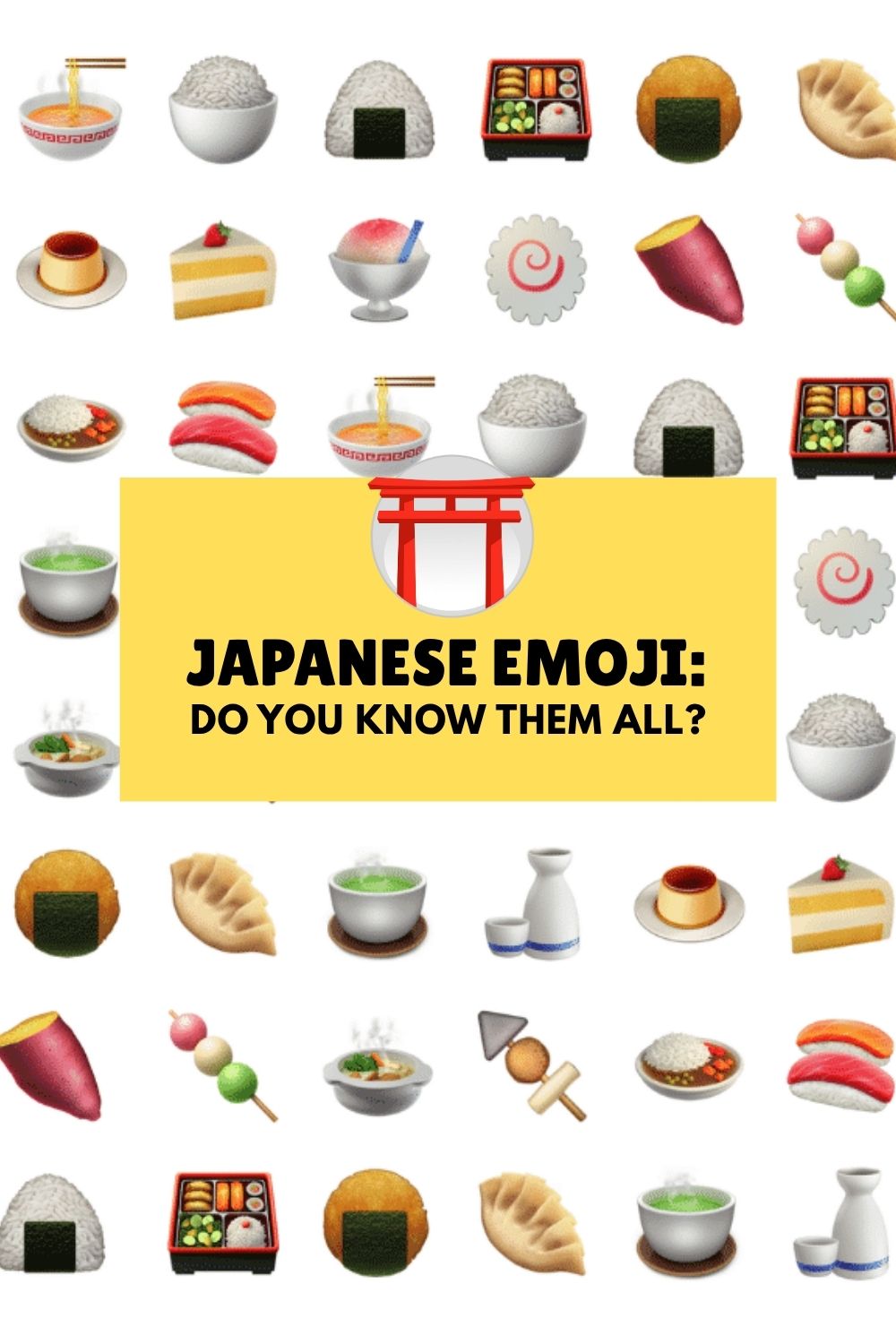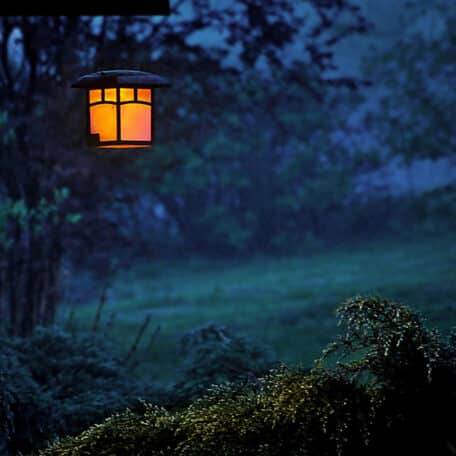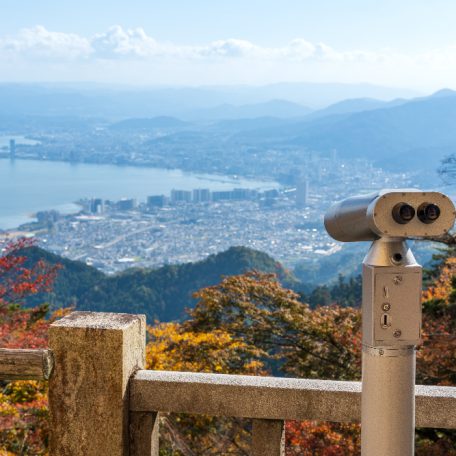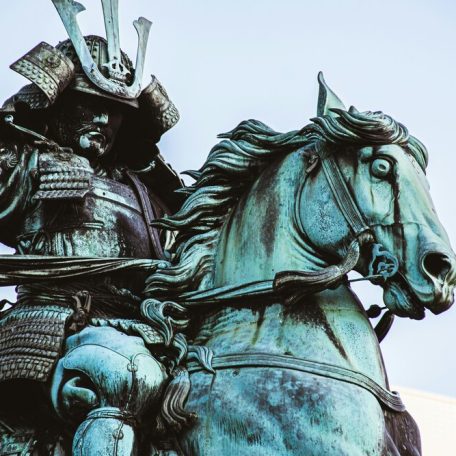JAPANESE EMOJI: DO YOU KNOW THEM ALL?
Apr 6, 2022
BY Carlotta Villa

Emoji entered our vocabulary as a second alphabet. But perhaps not everyone knows that emoji were invented in Japan way back in the 90s!
Emoji represent many aspects of Japanese culture, and it is precisely for this reason that some images may be difficult to decipher, or it’s easy to mistake their true meaning.
From monuments to traditional objects to everyday gestures, emoji heavily reflect Japan and its culture, and today we’re going to learn all about those food emoji that maybe you couldn’t quite figure out (spoiler alert: is are Japanese food!)
But before we dive in, let’s look at the history of emoji first.
Where do emojis come from?
Not to be confused with emoticons (from English emotion + icon), which are smileys made with punctuation marks – like this one 🙂 – , emoji are a Japanese creation.
In fact, the term emoji itself comes from the fusion of the Japanese words “e” (絵) that means “image” and “moji” (文字) that means “character”. The similarity is a mere coincidence since they have different etymologies! Emoji, like emoticons, also express emotions, but in their evolution they have come to represent animals, objects, foods, places, flags and so on.
As we said, emoji have their origins in Japan, and Shigetaka Kurita was their creator.
In the late 90s, Kurita was part of the developing team of NTT DoCoMo (A Japanese phone operator company) and their new i-mode network. This was one of the first mobile networks in the world, and because it was a novelty, messaging via i-mode was quite expensive as it cost money per character. In order to be more cost-effective, the team wanted to summarize ideas in small drawings that represented a single character. And so, in 1999, Kurita created the first emoji. He designed 176 pictograms based on manga, road signs, and ideograms. This started a super popular trend in Japan that escalated at the same speed as mobile technology. Every telephone company in the country started creating their own emoji, thus becoming an essential part of the Japanese language and, since 2005, an essential part of languages all over the world as well.
Fun fact: the original emoji set (drawn on a 12×12 pixel grid) has been part of the Museum of Modern art (MoMa) collection since 2019!
Japanese food emoji
🍣 Nigiri sushi 🍣
Let’s start with one of the most famous and probably most recognised Japanese emoji: sushi! This emoji in particular represents nigiri, probably the most traditional type of sushi that consists solely of sushi rice topped by a piece of fish or other toppings.

Image source: Canva
🍜 Ramen 🍜
Every Japanese food lover probably has already recognized it: this emoji represents ramen, the world-renowned Japanese noodle soup. Ramen is the protagonist of films, books, documentaries, photography exhibitions, cooking classes, television programs and is of course unmissable in an emoji keyboard. There are so many ramen varieties and basically each Japanese Prefecture has its own ramen recipe!

Image source: Canva
🍱 Bento 🍱
This emoji represents the bento, a traditional Japanese lunch box whose origin dates back to the 1600s! The box is divided in different compartments, and contains a complete meal. A bento can be made at home, or bought in a supermarket, convenience store, or local shops.

Image source: Canva
🍙 Onigiri 🍙
THE Japanese snack, His Excellency, the Onigiri.
Ok, I might be a bit biased because it’s my favorite snack, but it actually is an institution in Japanese food culture! Even if you’ve never tried them, you’ve probably already seen this dish in anime or manga. Also known as omusubi, onigiri are triangular or cylindrical rice balls often wrapped in seaweed. There are so many onigiri fillings, from traditional ones such as umeboshi (Japanese pickled plum) or kombu (seaweed) to more modern ones like tuna and mayonnaise.

Image source: Canva
🍚 Gohan 🍚
The base of Japanese cuisine and for sure essential in the emoji keyboard. White rice (gohan in Japanese) is present in every single Japanese meal: it can be eaten for breakfast, lunch, or dinner and can be enjoyed as it is or with different toppings.

Image source: Canva
🥟 Gyoza 🥟
Another popular Japanese dish: these dumplings, or gyoza, are the Japanese descendants of the Chinese jiaozi. The Japanese version of the classic gyoza includes a filling of minced meat (usually pork or chicken), spring onions, ginger, and garlic. There are different cooking styles, but the most popular one is pan-fried. Gyoza are a staple in izakayas (Japanese style pubs) and ramen shops, and pair well with beer and sake!

Image source: Canva
🍵 Green Tea 🍵
My mom always sends me this emoji thinking it means soup, however (so sorry to break it to you mom), this emoji actually refers to green tea! A staple in Japan’s culture, here represented in its traditional cup without a handle called yunomi.

Image source: Canva
🍶 Sake 🍶
It might not be easy to tell at first glance, but this emoji actually represents sake, the famous fermented rice wine that dates back thousands of years! The emoji depicts the traditional sake drinkware: tokkuri (sake flask) and ochoko (small sake cup). These are usually ceramic, but can be made of other materials too!

Image source: Canva
🍠 Yaki Imo – Roasted Sweet Potato 🍠
This emoji can be found in the fruit and vegetable section of your emoji keyboard, and the reason is because it’s a sweet potato! However this is no regular sweet potato: it’s called yaki imo, a Japanese roasted sweet potato. Yaki imo is a popular winter street food. If you visit Japan during the winter season, you will surely find stands that roast potatoes on a grill. Sweet potatoes have different colors in different parts of the world, and the one in the keyboard is the Japanese type: purplish color on the outside and yellow on the inside.

Image source: Canva
🍮 Pudding 🍮
I know what you’re thinking: was there really the need to create a pudding emoji? Well, pudding (or purin in Japanese) is actually one of the most popular desserts in Japan loved by both children and adults. Similar to a crème caramel or a flan, it’s so well-loved that you can literally find it in every supermarket or convenience store all over Japan! So yes, purin definitely earned its spot in the emoji keyboard.

Image source: Canva
🍰 Strawberry shortcake 🍰
What may look like a regular cake, is actually a really traditional Christmas dessert in Japan! It’s called strawberry shortcake, and it consists of a soft sponge cake with a whipped cream filling and decorated with strawberries. Nowadays it can be found all-year round but it becomes super popular around Christmas time!

Image source: Canva
🍥 Naruto 🍥
This funny-shaped emoji it’s called naruto, a kind of fish cake (or kamaboko) that can usually be found as a decoration in ramen or soba soups. But why is it shaped like this? Well, the spiral in the center refers to the whirlpools of the Naruto Strait located in the Kansai area (south of Japan)!

Image source: Canva
🍘 Senbei 🍘
This emoji might look like an onigiri, but it’s actually a senbei, a traditional Japanese rice cracker. Senbei are eaten as snacks (much like potato chips), and are great with green tea or beer! There are many varieties of senbei, both sweet and savory, but the one depicted in the emoji has a soy sauce glaze and is wrapped with nori (seaweed).

Image source: Canva
🍧 Kakigori 🍧
Not a slushie nor an ice cream, this emoji represents one of the most popular Japanese summer treats: kakigori!
Kakigori is a dessert made from thin flakes of ice flavored with syrups, often served with other ingredients such as fresh fruit, condensed milk, and cream. What makes kakigori stand out is the consistency of the ice that is cut with a special machine that makes it similar to fresh snow!

Image source: Canva
🍛 Curry Rice 🍛
This emoji represents a typical Japanese home-cooked dish called curry rice (or karē raisu in Japanese). It is a stew usually made with meat, onions, potatoes, and carrots in a curry-flavored sauce, served with white rice and eaten with a spoon. Unlike other types of curry dishes, which tend to be spicy, the Japanese version tends to be more sweet.

Image source: Canva
🍲 Nabe 🍲
What would appear to be an ordinary stew is actually one of the most beloved Japanese comfort foods called nabe. Nabe is a hotpot of different ingredients cooked slowly in a pot placed in the middle of the table. It’s a warming dish perfect for the winter months and is made to be shared and enjoyed together!

Image source: Canva
🍢 Oden 🍢
Before writing this blog, I asked my family to try and guess what all these emoji might represent, and when it came to this one, they honestly had no clue. I received all sorts of answers from “meat skewer” to “a funny shaped dessert”. But fear not, family and readers, because I’m here to shed light on this mysterious emoji!
It’s called oden, and it is a delicious Japanese winter food. It’s a stew of different ingredients in a light broth and can be served on a skewer. The three ingredients in particular in this emoji are the konnyaku (or konjac), a chicken meatball and a fishcake. Mystery solved!

Image source: Canva
🍡 Hanami Dango 🍡
“It’s a toy!” “It’s a candy!” No, it’s hanami dango!
I think that this, together with the oden emoji, is one of the most difficult emoji to decipher! That is because it’s an item that can only be found during the spring season in Japan, in particular during the cherry blossom season called hanami. Hanami dango is a dessert consisting of three mochi balls served on a skewer. The three colors represent the colors of the season: pink for the cherry blossoms, green for the newly born leaves, and white for the snow that melts to make way for spring.

Image source: Canva
As you saw, emoji are deeply rooted in Japanese culture, did you know them all? If not, now you’re a true emoji expert, giving you bragging rights among your friends and family!
Learn more about Japanese foods on our TOP 5 Foods online experience!
PIN THIS FOR LATER
Book your pocket wifi now to stay connected through your entire Japan Journey!

Be sure to get the JR Pass to make navigating Japan during your trip that much easier!

YOU MIGHT ALSO LIKE





